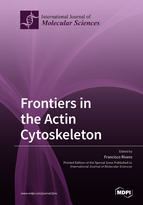Frontiers in the Actin Cytoskeleton
A special issue of International Journal of Molecular Sciences (ISSN 1422-0067). This special issue belongs to the section "Biochemistry".
Deadline for manuscript submissions: closed (29 November 2019) | Viewed by 71940
Special Issue Editor
Interests: actin cytoskeleton; actin-binding proteins; Rho GTPases; cyclase-associated protein; coronin; plastin; cell motility; platelet biology; endothelial cell biology
Special Issues, Collections and Topics in MDPI journals
Special Issue Information
Dear Colleagues,
The actin cytoskeleton is of fundamental importance for eukaryotic cell homeostasis. It contributes to developing and maintaining cell shape and tissue integrity and is crucial for cell migration, movement of organelles, vesicle trafficking, and the completion of cell division. Elaborate structures like the sarcomere, the inner ear cell streocilia, and the brush border microvilli are built on actin filaments scaffolds. Dozens of actin-binding proteins orchestrate the dynamic remodeling of the actin cytoskeleton and integrate it with cell signaling machinery. Impressive advances have been made in recent years towards understanding the intricacies of the microfilament system’s organization and function. This Special Issue of IJMS will cover a broad range of cutting-edge aspects related to the actin cytoskeleton, like the dynamics of remodelling, actin-binding proteins, biomechanics, visualisation techniques, actin-specific drugs, and diseases related to components of the microfilament system.
Dr. Francisco Rivero
Guest Editor
Manuscript Submission Information
Manuscripts should be submitted online at www.mdpi.com by registering and logging in to this website. Once you are registered, click here to go to the submission form. Manuscripts can be submitted until the deadline. All submissions that pass pre-check are peer-reviewed. Accepted papers will be published continuously in the journal (as soon as accepted) and will be listed together on the special issue website. Research articles, review articles as well as short communications are invited. For planned papers, a title and short abstract (about 100 words) can be sent to the Editorial Office for announcement on this website.
Submitted manuscripts should not have been published previously, nor be under consideration for publication elsewhere (except conference proceedings papers). All manuscripts are thoroughly refereed through a single-blind peer-review process. A guide for authors and other relevant information for submission of manuscripts is available on the Instructions for Authors page. International Journal of Molecular Sciences is an international peer-reviewed open access semimonthly journal published by MDPI.
Please visit the Instructions for Authors page before submitting a manuscript. There is an Article Processing Charge (APC) for publication in this open access journal. For details about the APC please see here. Submitted papers should be well formatted and use good English. Authors may use MDPI's English editing service prior to publication or during author revisions.
Keywords
- actin dynamics
- motility
- cell migration
- actin-specific drugs
- actin probes
- actin-binding proteins







